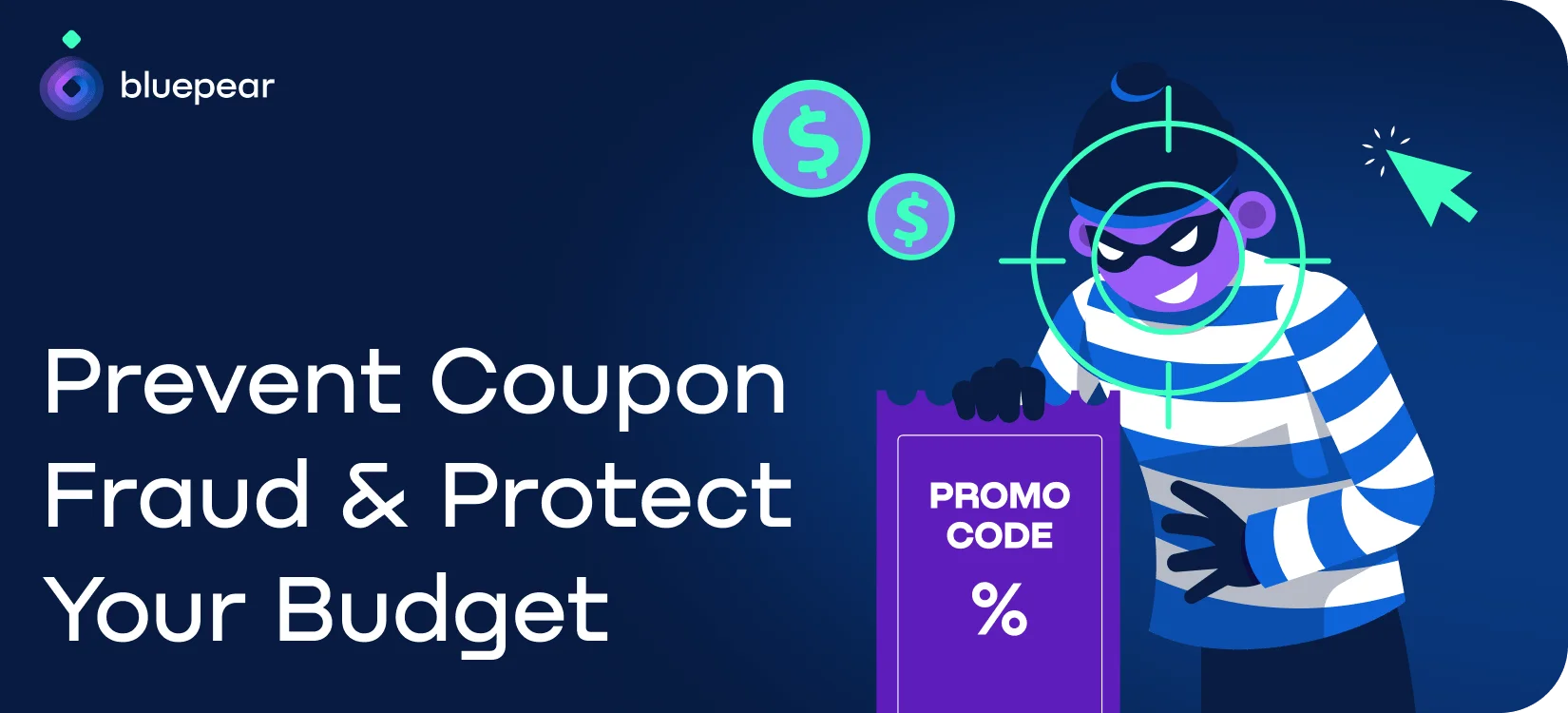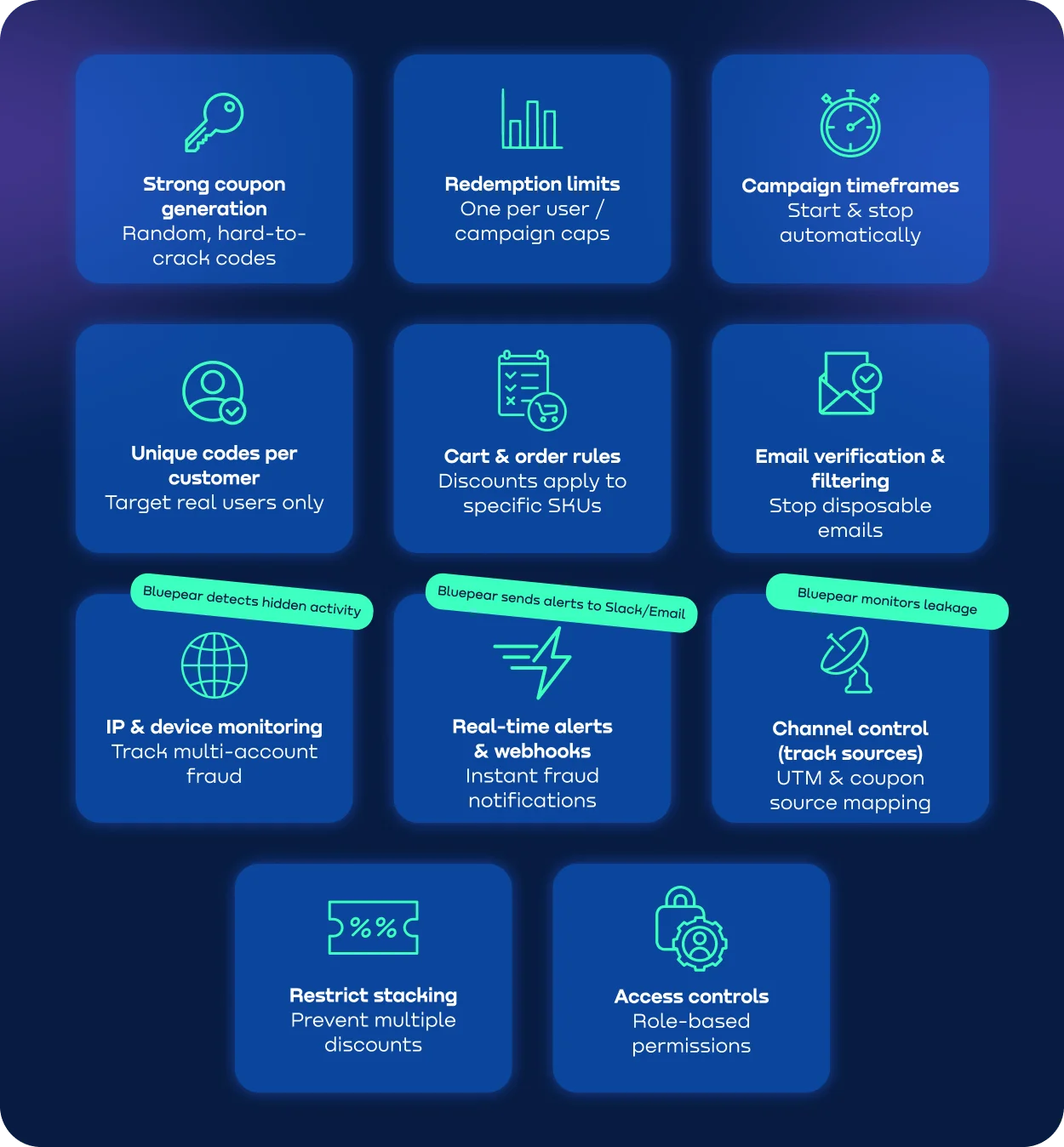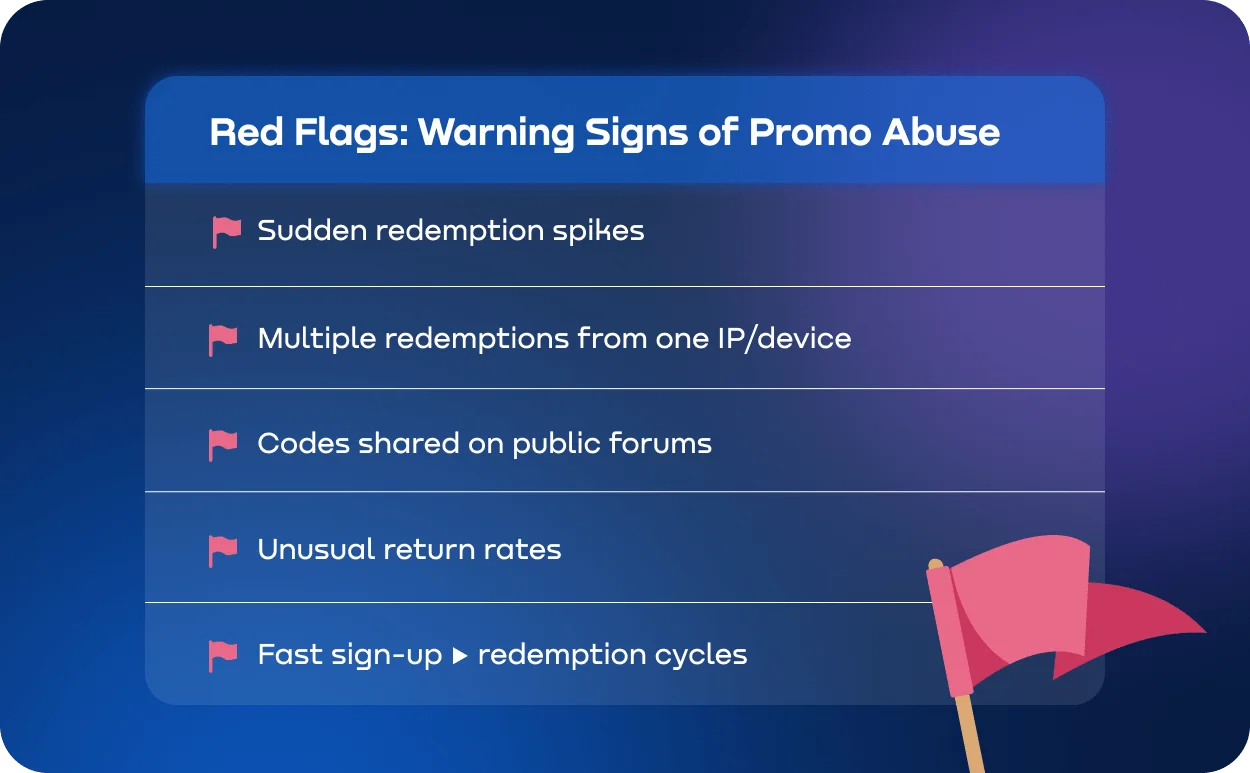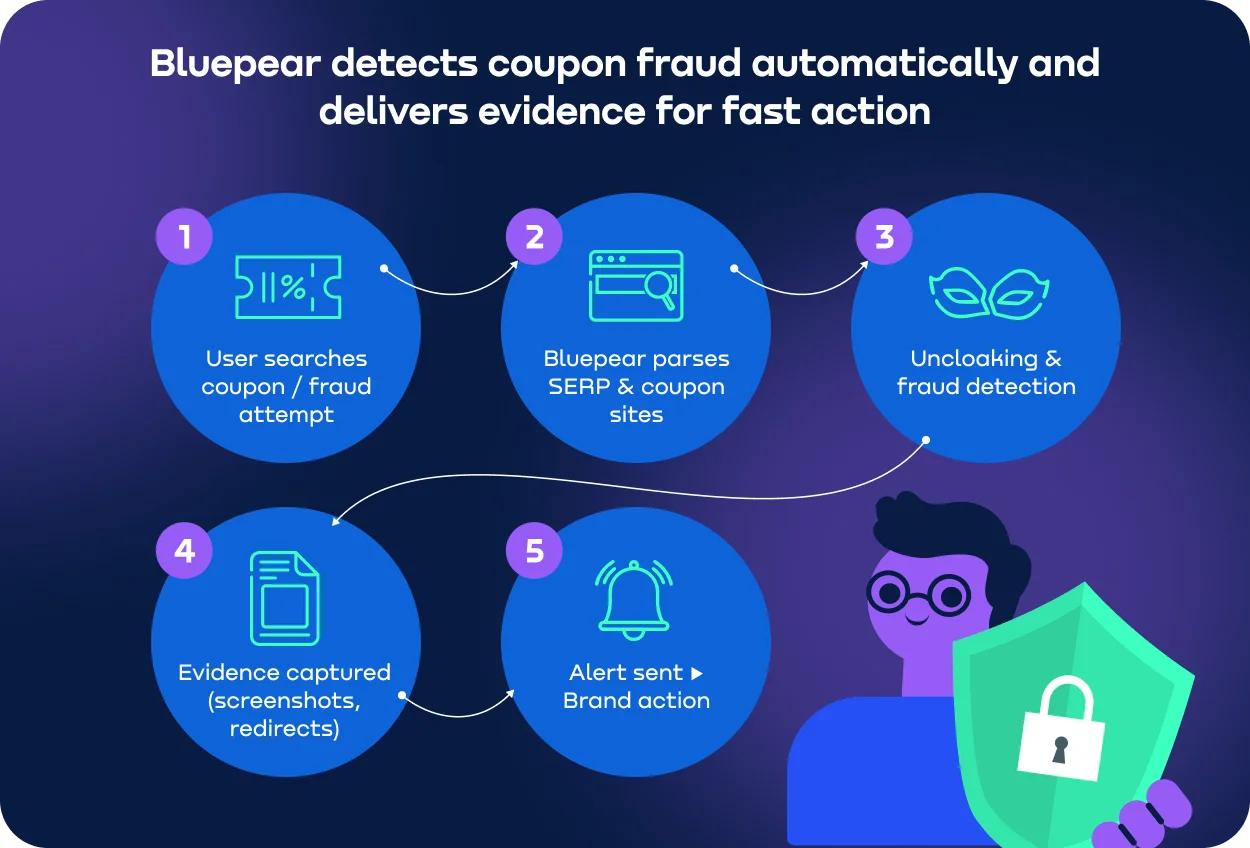
Contents
Coupon fraud has become a mainstream challenge for online businesses. Recent studies show that 73% of retailers worldwide have faced some form of coupon or promo code abuse, with billions lost each year to fraudulent redemptions. The problem spikes during peak sales events like Black Friday, where research suggests that up to one in three coupon users can be “fake shoppers” exploiting promotions with no real purchase intent. For e-commerce, affiliate programs, and performance marketing teams, this isn’t just about lost revenue. Coupon abuse erodes margins, skews campaign data, and undermines customer trust. Left unchecked, it can quietly drain budgets and give unfair advantages to bad actors.
What is Coupon Fraud and Promotion Abuse?
Coupon fraud and promotion abuse occur when individuals or organized groups exploit promotional codes in ways that were never intended by the business. This can take several forms:
- • Coupon misuse. When a customer deliberately redeems a discount under conditions that do not apply (e.g., using a “new customer only” promo on multiple accounts).
- • Fraudulent coupons. Codes that are stolen, generated without authorization, or leaked online by affiliates or third parties.
- • Fake coupon codes. Entirely fabricated codes shared on forums or coupon websites trick shoppers into believing they are legitimate.
It’s important to distinguish between genuine mistakes and systematic abuse. Coupon fraud is intentional, often repeated, and aimed at maximizing fake discounts. Unlike one-off customer errors, discount fraud can be scaled, automated, and even monetized by affiliate partners or competitors.
Most Common Types of Promotion Abuse
- • Coupon fraud doesn’t happen in one form. Fraudsters and opportunistic users employ a variety of tactics that can silently erode profitability. The most widespread include:
- • Code cracking. Fraudsters use scripts or manual “guessing” techniques to identify working promo codes. Once cracked, the code can spread quickly online.
- • Multiple redemptions and multi-accounting. Many brands limit coupons to first-time buyers, but abusers create endless new accounts with slightly modified details.
- • Fake emails and disposable inboxes. Fraudsters rely on temporary email services to redeem “one per customer” offers repeatedly. Some even automate the process.
- • Mass sharing on forums and coupon aggregators. Exclusive or targeted codes often leak to coupon scammer sites and social media groups. A discount intended for a limited segment can suddenly be redeemed thousands of times.
- • Excessive discount stacking. Abusers test combinations of multiple coupons or referral bonuses to achieve extreme discounts.
- • Fake complaints and exploiting T&C loopholes. Some customers intentionally misinterpret vague terms or repeatedly claim codes “failed to apply.” Support teams under pressure often issue replacement discounts.
- • Referral and fake order fraud. Fraudsters create networks of fake accounts that place bogus orders only to trigger referral bonuses, credits, or loyalty rewards.
Each of these practices may seem like small “one-offs,” but at scale they can cause significant revenue leakage, distort KPIs, and damage long-term campaign strategies.
The Hidden Costs of Coupon Fraud
The real danger of fake coupons goes far beyond the immediate discount lost on a single transaction. For businesses operating in e-commerce, fintech, SaaS, or travel, the hidden costs can compound quickly:
- • Revenue leakage. Every fraudulent redemption represents paying twice: once in the form of a discount that shouldn’t have been applied, and again in lost margin that could have been captured from a genuine customer. Over time, this creates silent revenue erosion that CFOs rarely see until it is too late.
- • Distorted analytics and false attribution. Fake coupon use inflates customer acquisition numbers and corrupts marketing data. Campaigns may look successful on paper, while in reality, they attract no net-new customers. Affiliate programs often end up paying commission on fake conversions, misallocating budget, and skewing performance reporting.
- • Reputational harm. Customers who find invalid or expired codes on public coupon sites often blame the brand, not the fraudster. This leads to frustration, poor user experience, and damage to customer trust. In competitive markets, even a few negative interactions can push shoppers toward competitors.
- • Operational complexity. Teams forced to manually review suspicious coupon use face a growing workload. Customer support, affiliate managers, and finance teams waste valuable hours resolving disputes, validating transactions, and chasing down abuse patterns.
How Coupon Fraud is Evolving with AI
As businesses embrace automation to optimize their marketing, fraudsters are doing the same. Artificial intelligence is making coupon abuse faster, harder to detect, and more scalable than ever before. Key trends include:
- • AI-powered bots are bypassing defenses. Traditional protections like CAPTCHA or rate limits are increasingly ineffective. AI-driven bots can mimic human behavior, rotate IPs, and interact with websites in ways that appear legitimate. This allows them to test and redeem thousands of promo codes undetected.
- • AI-generated “legit” email accounts. Fraudsters now use AI tools to create realistic email addresses, complete with unique names and patterns that resemble genuine customer data. Unlike disposable inboxes, these accounts are harder to flag and can be scaled by the hundreds or thousands.
- • Predictive promo abuse. By analyzing past promotions, AI can predict likely discount patterns (e.g., seasonal offers, numeric sequences, or standard percentage discounts). Fraudsters exploit this foresight to crack codes faster and prepare mass abuse campaigns before promotions even go live.
This shift means coupon fraud is becoming industrialized and algorithm-driven. For businesses, the implication is clear: manual reviews or basic validation rules are no longer sufficient. Proactive, automated detection strategies are required to stay ahead of fraudsters who are using the same advanced tools marketers rely on.
Debunking Myths about Coupon Scammers
Despite the growing evidence, coupon fraud is still surrounded by misconceptions. Many companies underestimate the damage because of three persistent myths:
“It’s low impact”
Some brands assume coupon abuse is just a few dollars lost here and there. In reality, e-commerce fraud operates at scale. Abusers automate the process across dozens of accounts, campaigns, and geographies. What looks like small leaks quickly compounds into systemic revenue loss, distorting KPIs and damaging acquisition efficiency.
“It’s just the cost of doing business”
Accepting voucher fraud as inevitable is dangerous. Coupon abuse pollutes customer databases with fake accounts, inflates CRM records, and produces unreliable attribution data. This “dirty CRM” makes it harder to segment real customers, calculate lifetime value, or measure ROI accurately. The result? Marketing teams invest more but learn less, as their insights are based on corrupted data.
“It’s too complex to fight”
Another common myth is that coupon abuse is impossible to control without massive resources. In practice, automated solutions now make monitoring and enforcement feasible. Tools like Bluepear provide 24/7 surveillance, evidence gathering (screenshots, redirect chains), and real-time alerts delivered into your preferred workflow. Instead of chasing fraud manually, businesses can rely on continuous monitoring that protects budgets while freeing teams to focus on growth.
The truth is that coupon abuse is a strategic threat. But with the right technology and policies can mitigate coupon fraud.
How to Prevent Coupon Fraud: Technical Best Practices
Fighting coupon abuse demands a robust technical framework. Below is a checklist of best practices every business should implement:
- • Strong coupon generation. Avoid predictable patterns (e.g., WELCOME10, WELCOME20). Use randomized alphanumeric strings that are difficult to guess or brute-force.
- • Redemption limits. Restrict coupons to one use per customer or per account to prevent mass exploitation.
- • Clear campaign timeframes. Define strict start and end dates to avoid legacy coupons being used months later.
- • Unique codes per customer. Personalized, single-use coupons significantly reduce the risk of mass sharing.
- • Cart and order rules. Define conditions (minimum spend, product category, or exclusions) to ensure coupons apply only where intended.
- • Email verification and filtering. Require verified, valid emails; block disposable domains to prevent bulk abuse.
- • IP and device monitoring. Detect suspicious behavior, such as multiple redemptions from the same device or IP range.
- • Real-time alerts and webhooks. Immediate detection enables fast action. Bluepear delivers instant notifications and proof when abuse is detected.
- • Channel control. Track coupon distribution sources. If a code leaks to aggregators, shut it down before losses mount. Bluepear automatically monitors traffic sources and provides evidence of misuse.
- • Restrict stacking. Prevent combining multiple discounts unless specifically intended.
- • Access controls. Limit who inside your organization can create, edit, or publish coupon codes to reduce the risk of leaks.
A layered defense, combining strict redemption logic and continuous monitoring, is the only way to stay ahead of evolving fraud tactics.

Strategic Best Practices to Mitigate Coupon Fraud Technical safeguards are critical, but strategy plays an equally important role in minimizing coupon abuse. Forward-thinking businesses adopt policies that make promotions both attractive to customers and resilient to fraud. Key strategic best practices include: Design promotions with built-in limits. Define clear guardrails from the start: cap redemptions, restrict by geography, or apply minimum purchase thresholds.
Prefer non-monetary rewards. Instead of heavy discounts, consider perks like loyalty points, VIP access, early product launches, or free upgrades. These drive engagement without being as easy to exploit.
Avoid free giveaways without purchase. Require a qualifying spend or action to unlock rewards. Zero-cost offers are magnets for fraud.
Pre-launch stress tests. Simulate real-world abuse scenarios before promotions go live. Identify loopholes and tighten rules proactively.
Clear terms & conditions and partner audits. Write T&Cs in plain language, close loopholes, and regularly audit affiliates or coupon distributors to ensure compliance.
Team education. Train marketing, affiliate, and customer support teams to recognize suspicious behavior and handle fraudulent complaints consistently.
Budget caps. Protect campaign ROI by capping total coupon liability. If abuse spikes, you won’t exceed your promotional budget. When combined with technical controls, these practices build a resilient promotional strategy that grows revenue while minimizing exposure to fraud.
Red Flags: Warning Signs of Promo Abuse
Early detection is key. Promo abuse often leaves behind recognizable patterns that can alert teams before losses escalate. Some of the most common warning signs include:
- • Sudden redemption spikes. A coupon meant for a small segment unexpectedly generates hundreds or thousands of redemptions in hours.
- • Multiple redemptions from the same IP or device. Indicates bots, shared accounts, or coordinated abuse campaigns.
- • Coupon codes appearing on public forums or aggregators. A strong indicator that an exclusive or private code has leaked and is being exploited beyond its target audience.
- • Unusual return or cancellation rates. Fraudsters often exploit coupons, then return or cancel orders, leaving the business with sunk costs but no revenue.
- • Fast account creation–redemption cycles. Dozens of accounts registered and redeemed within minutes suggest automated account farms exploiting “first-time user” offers.
Monitoring for these red flags helps businesses intervene quickly. With tools like Bluepear, companies gain 24/7 visibility into coupon activity, complete with screenshots, redirect tracking, and instant alerts when anomalies appear.

Why Automation is Essential In theory, businesses could mitigate coupon fraud manually: monitoring forums, testing coupon aggregators, checking redemption logs, and reviewing affiliate traffic one case at a time. But in practice, this approach is time-consuming, error-prone, and impossible to scale. By the time a human team detects a leak, hundreds of fraudulent redemptions may have already drained budgets. That’s why automation has become essential. Modern fraud requires continuous, intelligent monitoring that human teams simply cannot provide on their own. This is where Bluepear steps in:
- • 24/7 monitoring. Constant surveillance of SERPs, coupon sites, and affiliate traffic sources.
- • Evidence collection. Screenshots, redirect chains, and structured reports that provide undeniable proof for internal teams and partner negotiations.
- • Real-time alerts. Instant notifications delivered into your chosen workflow (Slack, email, dashboards) the moment suspicious activity is detected.
- • Uncloaking & affiliate fraud detection modules. Identify hidden redirects, cloaked links, and affiliate violations that standard analytics miss.
The results go beyond fraud detection. Automated monitoring ensures:
- • Budget savings. Stop revenue leakage before it scales.
- • Reputation protection. Prevent fake coupons from frustrating genuine customers.
- • Clean attribution. Ensure marketing and affiliate data reflect real performance, not inflated numbers from fraud.
With automation, fraud prevention becomes proactive rather than reactive, protecting both short-term revenue and long-term brand integrity.

Summing up
Coupon abuse is a manageable problem: with the right strategy and tools in place, businesses can protect both their budgets and their customers. If you’d like to see how automation makes this process simple, you can request a free demo of Bluepear. The platform provides continuous 24/7 monitoring of fake coupons, SERPs, and affiliate activity, complete with screenshots, redirect tracking, real-time alerts, and clear reports. A short consultation or demo is often enough to uncover hidden revenue leakage and show how clean attribution, stronger compliance, and budget savings can be achieved with far less effort.
FAQ
What is coupon fraud?
Coupon fraud (or promotion abuse) is the deliberate misuse of discount codes, such as cracking codes, creating fake accounts, or leaking exclusive offers, to gain benefits that were never intended by the business.
How can I detect fake coupons?
Fraud can be spotted by monitoring redemption patterns, auditing campaign data, and checking whether codes appear on public coupon sites or forums. Manual detection is possible but requires constant log reviews, forum checks, and affiliate audits, which quickly becomes unscalable.
What are the red flags of promotion abuse?
Warning signs include sudden spikes in redemptions, multiple coupon uses from the same IP or device, unusual return rates, codes circulating on coupon aggregators, and rapid account creation–redemption cycles.
What tools monitor coupon codes in real time?
Automated solutions like Bluepear provide 24/7 monitoring of coupon sites and SERPs, collect evidence (screenshots, redirect chains), and send real-time alerts. This makes detection faster and significantly mitigate coupon fraud.
How often should brands audit promotions?
Ideally, brands should audit campaigns continuously to prevent coupon scammers, especially during high-volume periods like Black Friday. At a minimum, every promotion should be stress-tested before launch and reviewed immediately after. Automation makes this process continuous rather than periodic.

